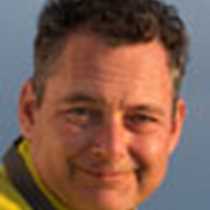We left behind San Cristobal, arriving to the oldest island of the Galapagos, Española (or Hood, its English name). Early in the morning we dropped anchor at Gardner Bay, waiting for the sun to rise so we could go out kayaking along the coast. After we spent the morning in the kayaks, paddling for the first time in the Galápagos, we observed a great number of sea birds and playful sea lions inviting us to swim with them in the crystalline waters. After breakfast we went out to explore the underwater world. We had the chance to observe sting rays, a school of razor surgeon fish, and the juvenile sea lions, who delighted us with their impressive acrobatics and tameness.
After snorkeling activities we visited a breathtaking white sand beach with turquoise water which was inhabited by a great number of Galapagos sea lions just recovering from a long night of fishing out in the ocean. It’s hard to think about sea lions being lazy since when we see them on land they are almost always sleeping, but try to dive down to a quarter of a mile and catch fish with your mouth and think about all the energy that would take from you! We also observed the inquisitive Espanola mockingbird running along the beach, trying to catch some flies or checking our backpacks with the idea to obtain some water, scarce during this part of the year in this part of the world.
In the afternoon, after short navigation, the National Geographic Islander arrived to Punta Suarez. It was sunny but windy, making for a very refreshing walk along the trail. As soon we landed on the small pier we observed marine iguanas facing to the sun while they warmed their bodies. On the beach behind them sea lions slept indifferently. Walking inland we arrived at Nazca booby territory which was covered completely with guano. We observed some of them nesting and others walking around us producing their unmistakable sounds. We crossed the iguana’s nesting area and finally our efforts were rewarded when we arrived at the waved albatross territory. We saw juveniles with their fluffy brown feathers and many others in pairs incubating their eggs, or just resting. All the while the imposing Galapagos hawk hovered over us looking for a prey.
Just after 6 PM we returned to the National Geographic Islander, observing a majestic sunset that brought the best memories of this great day on the oldest island of this beautiful archipelago.









